coolant CADILLAC SEVILLE 1996 4.G Owners Manual
[x] Cancel search | Manufacturer: CADILLAC, Model Year: 1996, Model line: SEVILLE, Model: CADILLAC SEVILLE 1996 4.GPages: 354, PDF Size: 20.21 MB
Page 14 of 354
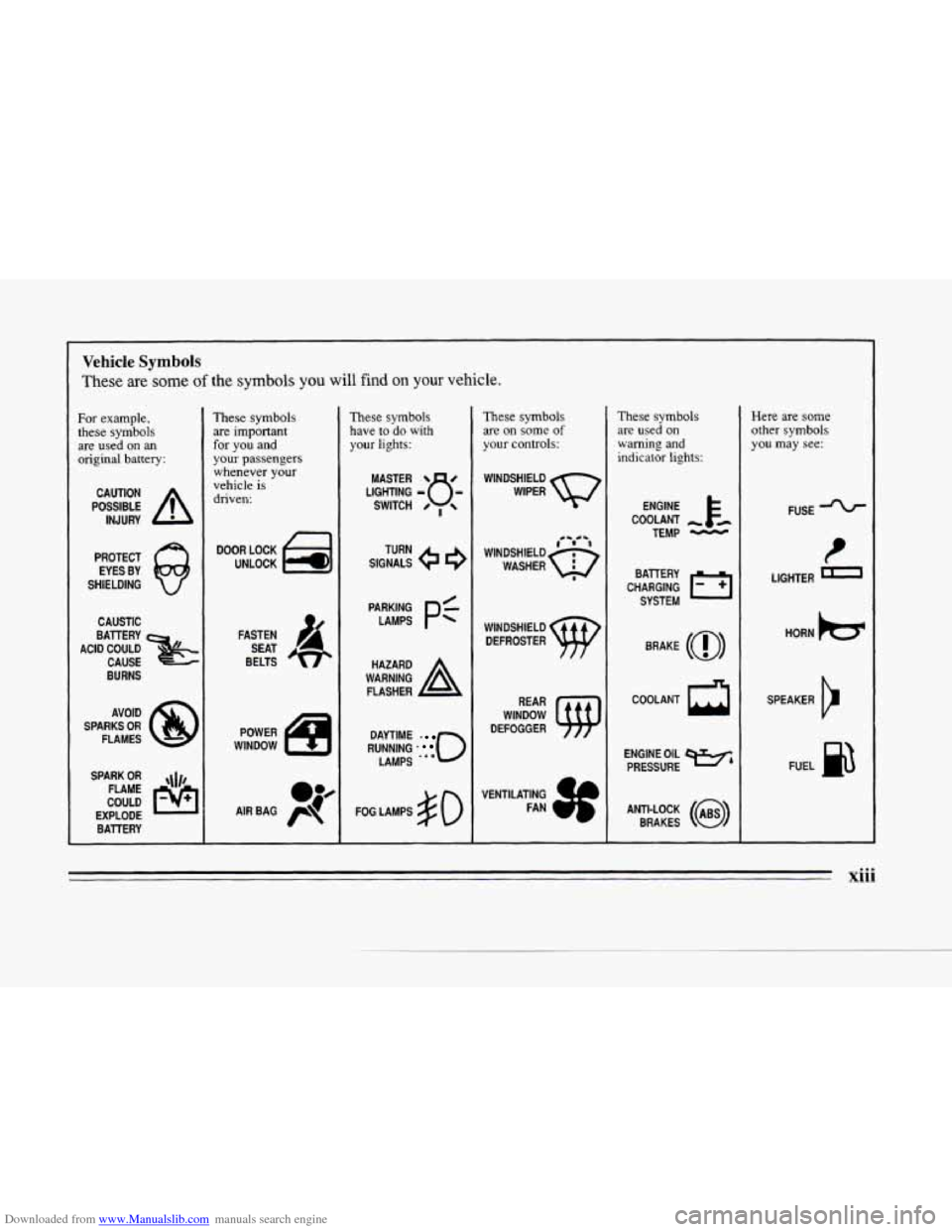
Downloaded from www.Manualslib.com manuals search engine e
e
c
Vehicle Symbols
These are some of the symbols you will find on your vehicle.
For example,
these symbols
are used
on an
original battery:
POSSIBLE A
CAUTION
INJURY
PROTECT
EYES BY
SHIELDING
CAUSTIC
BURNS AVOID
SPARKS
OR
FLAMES
SPARK
OR ,111,
COULD FLAME
EXPLODE BAllERY
These symbols
are important
for you and
your passengers
whenever your
vehicle
is
driven:
DOOR LOCK
UNLOCK
FASTEN SEAT
BELTS
POWER
WINDOW
These symbols have
to do with
your lights:
SIGNALS e
TURN
RUNNING
0
DAYTIME -
LAMPS -**
FOG LAMPS # 0
These symbols are on
some of
your controls:
WINDSHIELD
WIPER
WINDSHIELD DEFROSTER
WINDOW
DEFOGGER
VENTILATING FAN
These symbols
are used on
warning and
indicator lights:
COOLANT -
TEMP -
CHARGING I-1
BATTERY
SYSTEM
BRAKE
(a)
COOLANT a
ENGINE OIL w,
PRESSURE
ANTI-LOCK
(,)
BRAKES
Here are some
other symbols
you may see:
FUSE
LlGl ITER D
HORN k3
SPEAKER
k
FUEL B
xiii
Page 78 of 354

Downloaded from www.Manualslib.com manuals search engine Engine Coolant Heater (Option) (Canada
Only)
In very cold weather, 0°F (- I 8 O C) or colder, the engine
coolant heater can help.
You’ll get easier starting and
better fuel economy during engine
warm-up. Usually,
the coolant heater should be plugged in a minimum
of
four hours prior to starting your vehicle.
To use the coolant heater:
1. Turn off the engine.
2. Open the hood and unwrap the electrical cord.
3. Plug it into a normal, grounded 110-volt AC outlet.
I A CAUTION:
Plugging the cord into an ungrounded outlet
could cause an electrical shock.
Also, the wrong
kind
of extension cord could overheat and cause
a fire.
You could be seriously injured. Plug the
cord into
a properly grounded three-prong
110-volt
AC outlet. If the cord won’t reach, use a
heavy-duty three-prong extension cord rated for
at least
15 amps.
2-19
Page 79 of 354
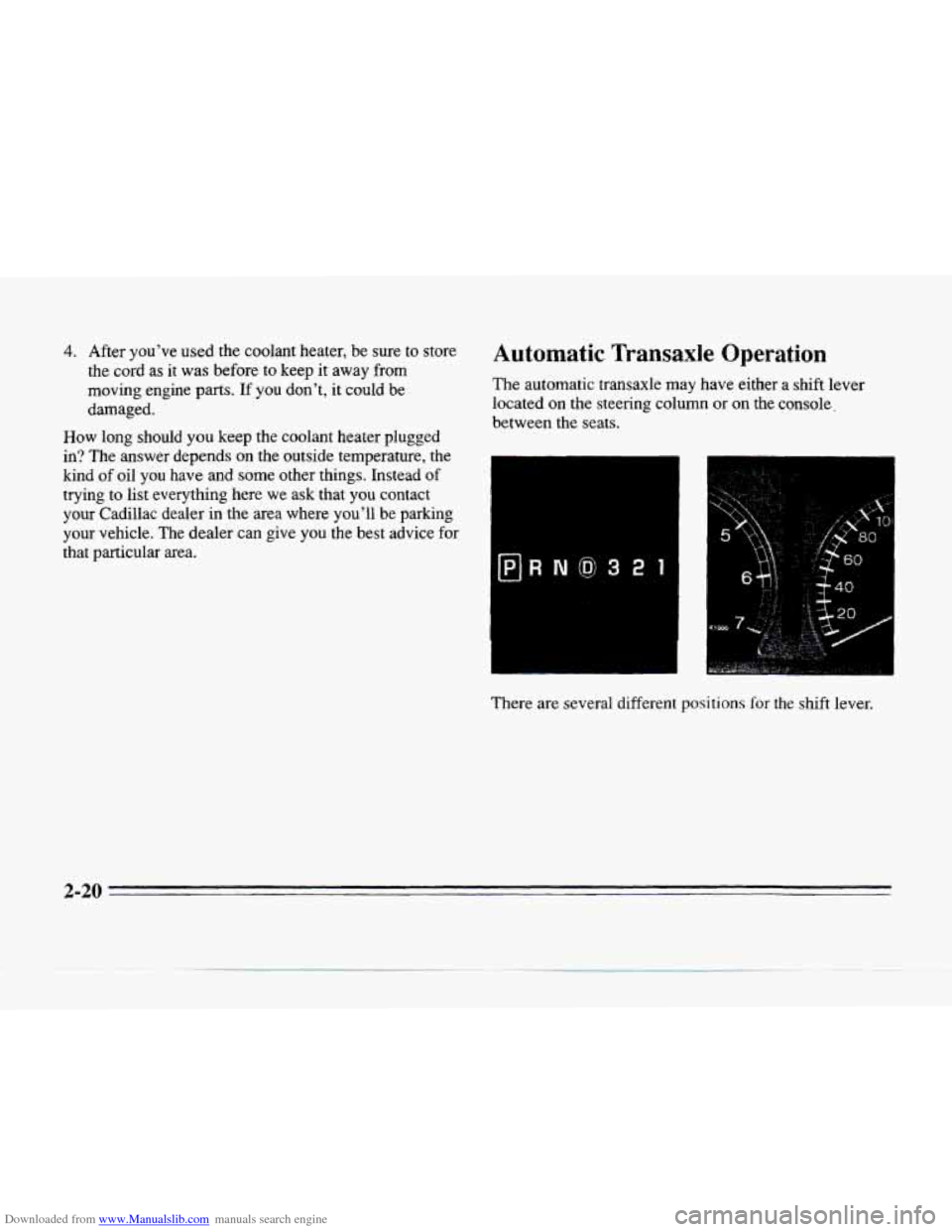
Downloaded from www.Manualslib.com manuals search engine 4. After you’ve used the coolant heater, be sure to store
the cord as it was before to keep it away from
moving engine
parts. If you don’t, it could be
damaged.
How long should you keep the coolant heater plugged
in? The answer depends on the outside temperature, the
kind of oil you have and some other things. Instead of
trying to list everything here we ask that you contact
your Cadillac dealer in the area where you’ll
be parking
your vehicle. The dealer can give you the best advice for
that particular area.
Automatic Transaxle Operation
The automatic transaxle may have either a shift lever
located on the steering column or on the console.
between the seats.
There are several different
positions for the shift lever.
2-20
Page 130 of 354
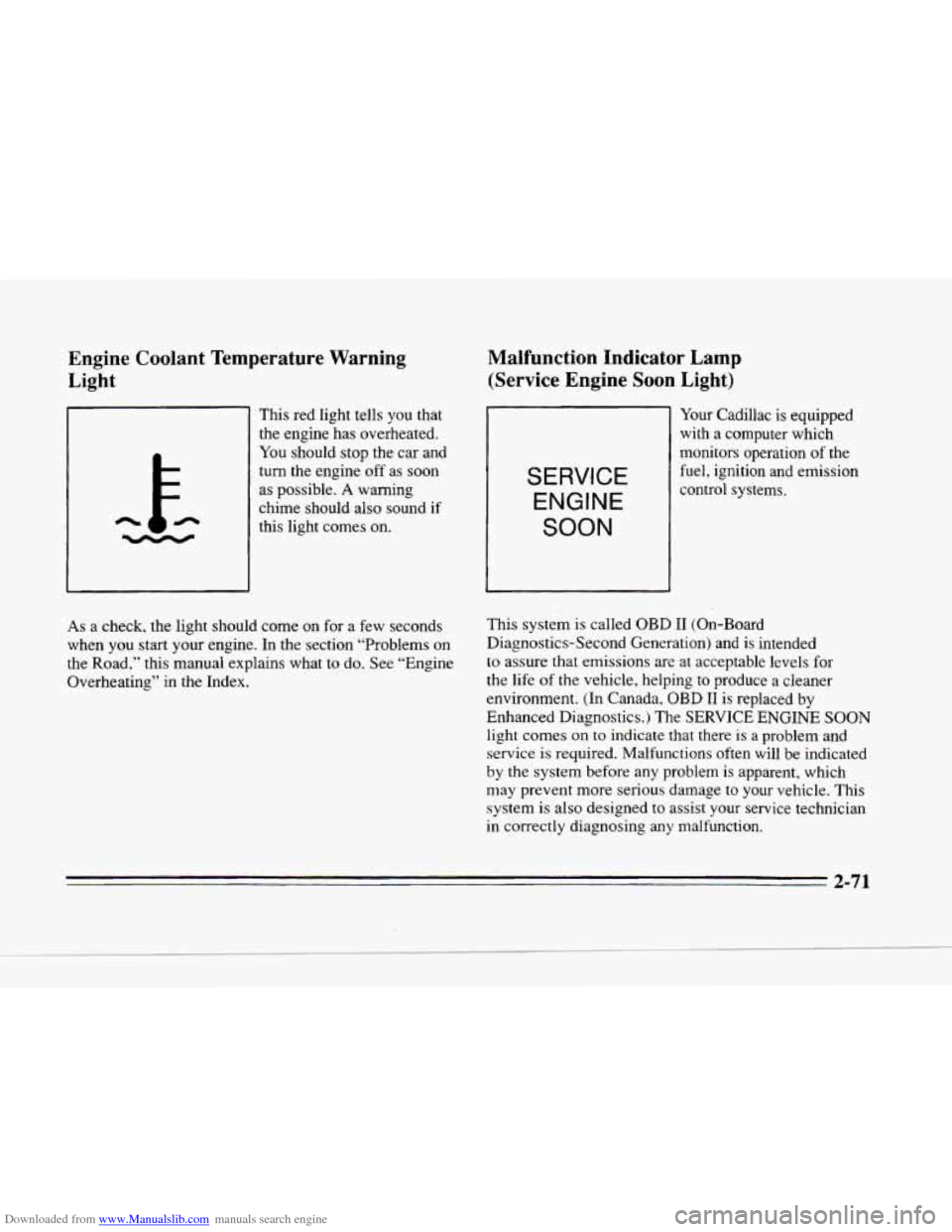
Downloaded from www.Manualslib.com manuals search engine Engine Coolant Temperature Warning
Light
This red light tells you that
the engine has overheated.
You should stop the car and
turn the engine off as soon
as possible.
A warning
chime should also sound if
this light comes on.
As a check, the light should come on for a few seconds
when you start your engine. In the section “Problems on
the Road,” this manual explains what to do. See “Engine
Overheating’’ in the Index.
Malfunction Indicator Lamp
(Service Engine
Soon Light)
SERVICE
ENGINE
SOON
Your Cadillac is equipped
with a computer which
monitors operation of the
fuel, ignition and emission
control systems.
This system is called OBD
I1 (.On-Board
Diagnostics-Second Generation) and is intended
to assure that emissions are at acceptable levels for
the life
of the vehicle, helping to produce a cleaner
environment. (In Canada,
OBD I1 is replaced by
Enhanced Diagnostics.) The SERVICE ENGINE SOON
light comes on to indicate that there is a problem and
service is required. Malfunctions often will be indicated
by the system before any problem is apparent, which
may prevent more serious damage to your vehicle. This
system is also designed
to assist your service technician
in correctly diagnosing any malfunction.
2-71
Page 136 of 354

Downloaded from www.Manualslib.com manuals search engine c
Driver Information Center (DIC)
The DIC display gives you the status of many of your
vehicle’s systems. The
DIC is used to display driver
selectable information and warning/status messages.
If more than one problem is detected, the DIC will
automatically display all current messages.
Digital Control Buttons
,
DISPLAY ON/OFF: Pressing this button will turn off
the DIC, Electronic Climate Control, fuel data center,
the fuel gage, trip odometer and odometer. While the
displays are
off, pressing the INFORMATION button
will only turn
on the DIC. If the TRIP SET button
is pressed
or the fuel level falls below four gallons
(15.2 L), all the displays will come back on.
ENG/MET (EnglishIMetric): You can change the
display from English (miles)
to metric (kilometers) by
pressing this button. The same button also changes other
readings (like temperature, fuel and odometer).
TRIP SET By using this button you can tell how far
you’ve gone since
you last set the TRIP SET back to
zero. To reset, press and hold the button until zeros
appear. If your vehicle is domestic, the trip odometer
will return
to zero after 999.9 miles (1 609 kmj. If your
vehicle
is Canadian, the trip odometer will return to zero
after
1 999.9 km (1,242 miles j.
INFORMATION: Pressing this button repeatedly will
display
the AVG MPG, FUEL USED, AVG MPH, OIL
LIFE LEFT, ENGINE RPM, BATTERY VOLTS and
COOLANT TEMP.
2-77
Page 139 of 354
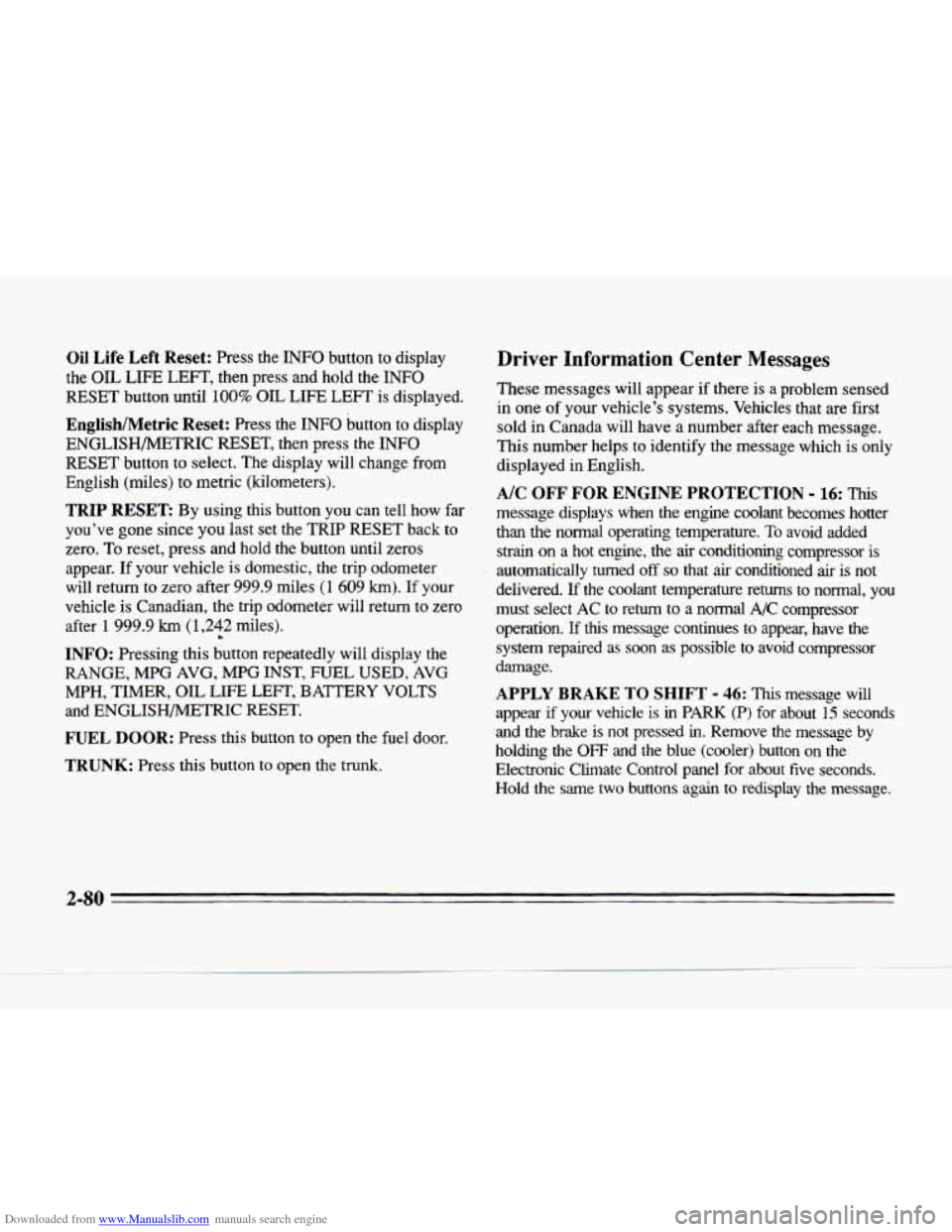
Downloaded from www.Manualslib.com manuals search engine Oil Life Left Reset: Press the INFO button to display
the
OIL LIFE LEFT, then press and hold the INFO
RESET button until
100% OIL LIFE LEFT is displayed.
English/Metric Reset: Press the INFO button to display
ENGLISHMETRIC
RESET, then press the INFO
RESET button to select. The display will change from
English (miles) to metric (kilometers).
TRIP RESET By using this button you can tell how far
you've gone since you last set the TRIP RESET back to
zero. To reset,' press and hold the button until zeros
appear.
If your vehicle is domestic, the trip odometer
will return to zero after 999.9 miles
(1 609 km). If your
vehicle is Canadian, the trip odometer will return to zero
after
1 999.9 km (1,242 L miles).
INFO: Pressing this button repeatedly will display the
RANGE, MPG AVG, MPG INST, FUEL USED, AVG
MPH, TIMER, OIL LIFE LEFT, BATTERY VOLTS
and ENGLISHMETRIC RESET.
FUEL DOOR: Press this button to open the fuel door.
TRUNK: Press this button to open the trunk.
Driver Information Center Messages
These messages will appear if there is a problem sensed
in one
of your vehicle's systems. Vehicles that are first
sold in Canada will have a number after each message.
This number helps to identify the message which is only
displayed in English.
message displays when the engine coolant becomes hotter
than the normal operating temperature.
To avoid added
strain on a hot engine, the air conditioning compressor is
automatically turned off so that air conditioned air is not
delivered.
If the coolant temperature rems to normal, you
must select
AC to return to a normal A/C compressor
operation.
If this message continues to appear, have the
system repaired as soon as possible to avoid compressor
damage.
A/C OFF FOR ENGINE PROTECTION - 16: "his
APPLY BRAKE TO SHIFT - 46: This message will
appear if your vehicle is in PARK (P) for about 15 seconds
and
the brake is not pressed in. Remove the message by
holding the
OFF and the blue (cooler) button on the
Electronic Climate Control panel for about five seconds.
Hold the same two buttons again to redisplay
the message.
2-80
Page 141 of 354
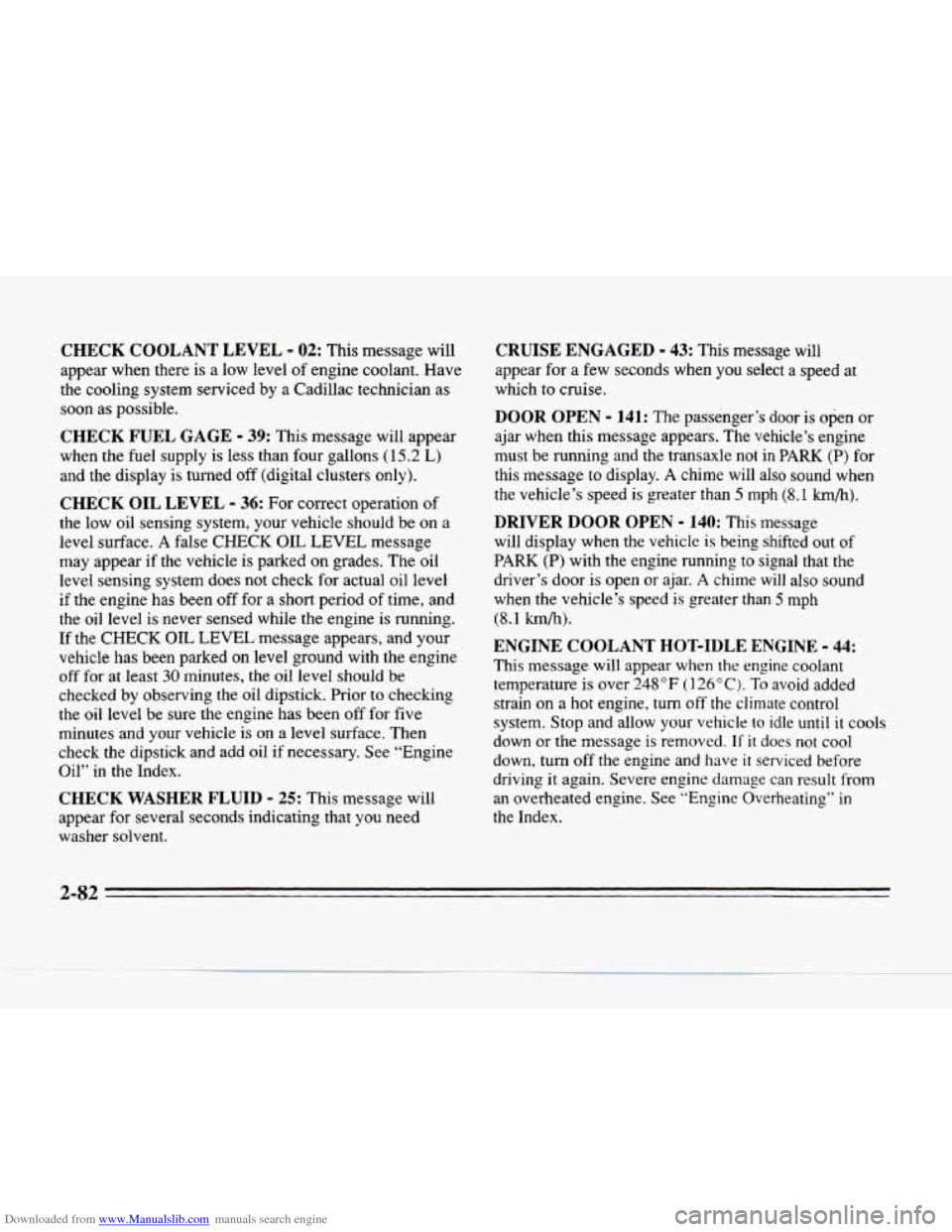
Downloaded from www.Manualslib.com manuals search engine CHECK COOLANT LEVEL - 02: This message will
appear when there is a low level of engine coolant. Have
the cooling system serviced by a Cadillac technician
as
soon as possible.
CHECK FUEL GAGE - 39: This message will appear
when the fuel supply is less than four gallons
(15.2 L)
and the display is turned off (digital clusters only).
CHECK OIL LEVEL - 36: For correct operation of
the low oil sensing system, your vehicle should be on a
level surface.
A false CHECK OIL LEVEL message
may appear if the vehicle
is parked on grades. The oil
level sensing system does not check for actual oil level
if the engine has been off for
a short period of time, and
the oil level is never sensed while the engine is running.
If the CHECK OIL LEVEL message appears, and your
vehicle has been parked on level ground with the engine
off
for at least 30 minutes, the oil level should be
checked by observing the
oil dipstick. Prior to checking
the oil level be sure the engine has been off for five
minutes and your vehicle
is on a level surface. Then
check the dipstick and add oil if necessary. See “Engine
Oil” in the Index.
CHECK WASHER FLUID - 25: This message will
appear
for several seconds indicating that you need
washer solvent.
CRUISE ENGAGED - 43: This message will
appear for
a few seconds when you select a speed at
which to cruise.
DOOR OPEN - 141: The passenger‘s door is open or
ajar when this message appears. The vehicle’s engine
must be running and the transaxle not
in PARK (I?) for
this message to display. A chime will also sound when
the vehicle’s speed is greater than
5 mph (8.1 km/h).
DRIVER DOOR OPEN - 140: This message
will display when the vehicle is being shifted out of
PARK (P) with the engine running to signal that the
driver’s door
is open or ajar. A chime will also sound
when the vehicle’s speed
is greater than 5 mph
(8.1 km/h).
ENGINE COOLANT HOT-IDLE ENGINE - 44:
This message will appear when the engine coolant
temperature is over
248 “F ( 1 24°C). To avoid added
strain on a hot engine, turn
off the climate control
system. Stop and allow your vehicle
to idle until it cools
down
or the message is removed. If it does not cool
down, turn off the engine and
have it serviced before
driving it again. Severe engine damage can result from
an overheated engine. See
“Engine Overheating” in
the Index.
2-82
Page 150 of 354
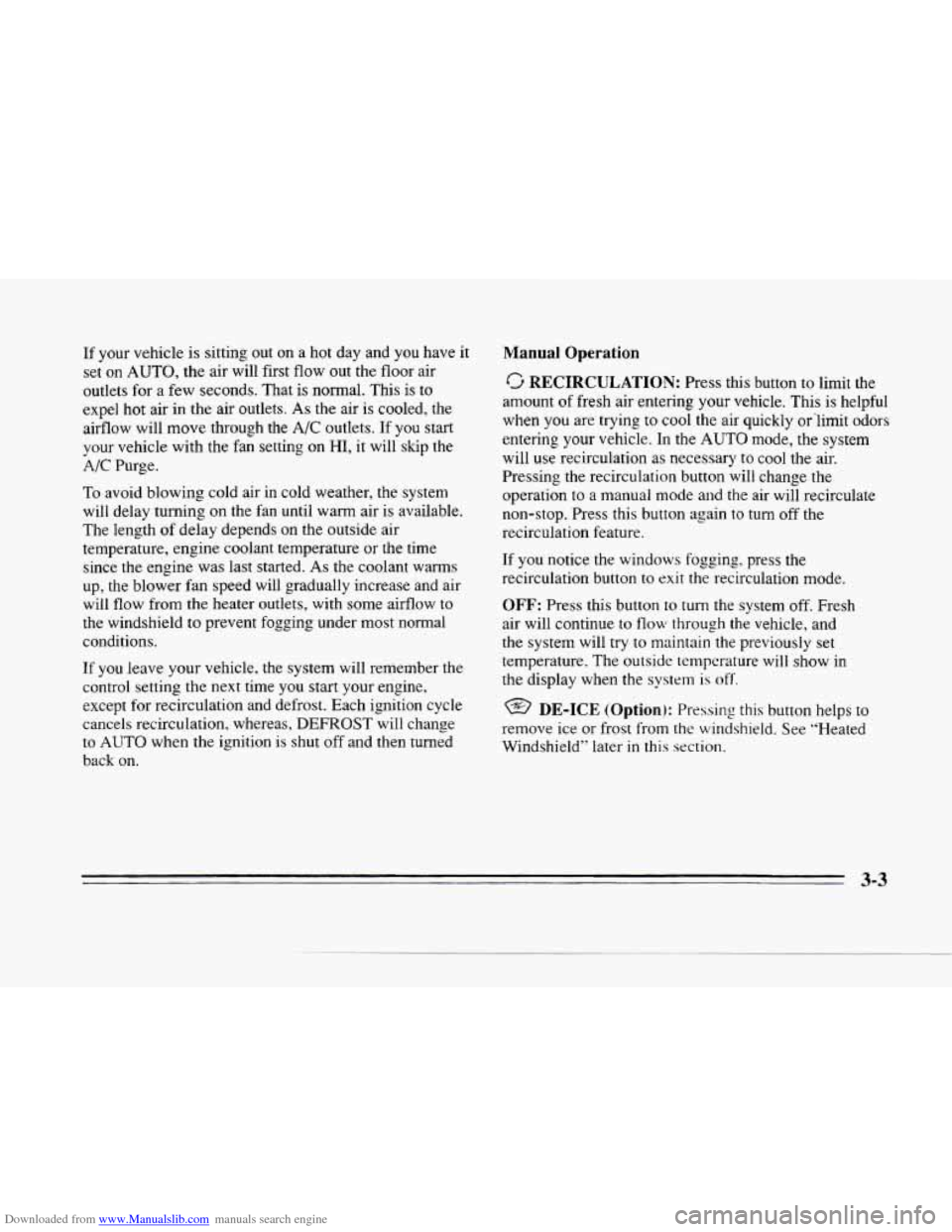
Downloaded from www.Manualslib.com manuals search engine c
If your vehicle is sitting out on a hot day and you have it
set on
AUTO, the air will first flow out the floor air
outlets for a few seconds. That is normal. This is
to
expel hot air in the air outlets. As the air is cooled, the
airflow will move through the
A/C outlets. If you start
vour vehicle with the fan setting on
HI, it will skip the
i/~ Purge.
To avoid blowing cold air in cold weather, the system
will delay turning on the fan until warm air is available.
The length
of delay depends on the outside air
temperature, engine coolant temperature or the time
since the engine was last started.
As the coolant warms
up, the blower fan speed will gradually increase and air
will flow from the heater outlets, with some airflow
to
the windshield to prevent fogging under most normal
conditions.
If you leave your vehicle, the system will remember the
control setting the next time
you start your engine,
except for recirculation and defrost. Each ignition cycle
cancels recirculation, whereas,
DEFROST will change
to
AUTO when the ignition is shut off and then turned
back on.
Manual Operation
RECIRCULATION:
Press this button to limit the
amount
of fresh air entering your vehicle. This is helpful
when you are trying
to cool the air quickly or ’limit odors
entering your vehicle. In
the AUTO mode, the system
will use recirculation
as necessary to cool the air.
Pressing
the recirculation button will change the
operation
to a manual mode and the air will recirculate
non-stop. Press this button again to turn off the
recirculation feature.
If you notice the windows fogging, press the
recirculation button
to exit the recirculation moae.
OFF: Press this button to turn the system off. Fresh
air will continue
to flow through the vehicle, and
the system will
try to maintain the previously set
temperature.
The outside temperature will show in
the display when the
system is off.
@ DE-ICE (Option): Pressing this button helps to
remove ice or frost from the windshield. See “Heated
Windshield’’ later
in this section.
Page 151 of 354
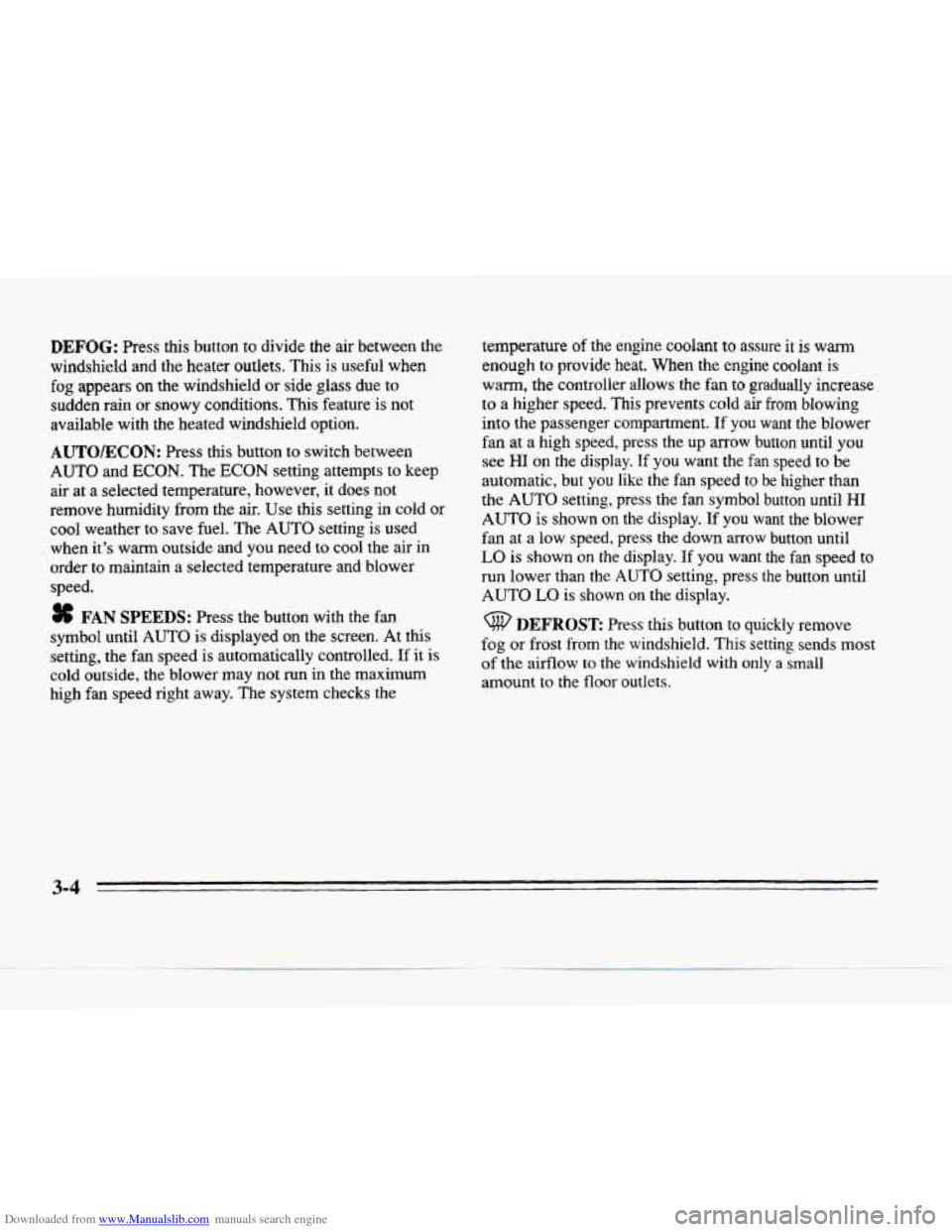
Downloaded from www.Manualslib.com manuals search engine DEFOG: Press this button to divide the air between the
windshield and the heater outlets. This
is useful when
fog appears on the windshield or side glass due to
sudden rain
ox snowy conditions. This feature is not
available with the heated windshield option.
AUTO/ECON: Press this button to switch between
AUTO and ECON. The ECON setting attempts to keep
air at
a selected temperature, however, it does not
remove humidity from the air. Use this setting in cold or
cool weather to save fuel. The
AUTO setting is used
when it’s warm outside and you need
to cool the air in
order to maintain a selected temperature and blower
speed.
* FAN SPEEDS: Press the button with the fan
symbol until
AUTO is displayed on the screen. At this
setting, the fan speed is automatically controlled. If it
is
cold outside, the blower may not run in the maximum
high fan speed right away. The system checks the temperature
of the engine
coolant to assure it is warm
enough to provide heat. When the engine coolant is
warm, the controller allows the fan to gradually increase
to a higher speed. This prevents cold air from blowing
into the passenger compartment.
If you want the blower
fan at
a high speed, press the up arrow button until you
see
HI on the display. If you want the fan speed to be
automatic, but you like the fan speed to
be higher than
the
AUTO setting, press the fan symbol button until .HI
AUTO is shown on the display. If you want the blower
fan at
a low speed, press the down arrow button until
LO is shown on the display. If you want the fan speed to
run lower than the
AUTO setting, press the button until
AUTO LO is shown on the display.
DEFROST Press this button to quickly remove
fog or frost from
the windshield. This setting sends most
of the airflow to the windshield with only a small
amount to
the floor outlets.
3-4
Page 154 of 354
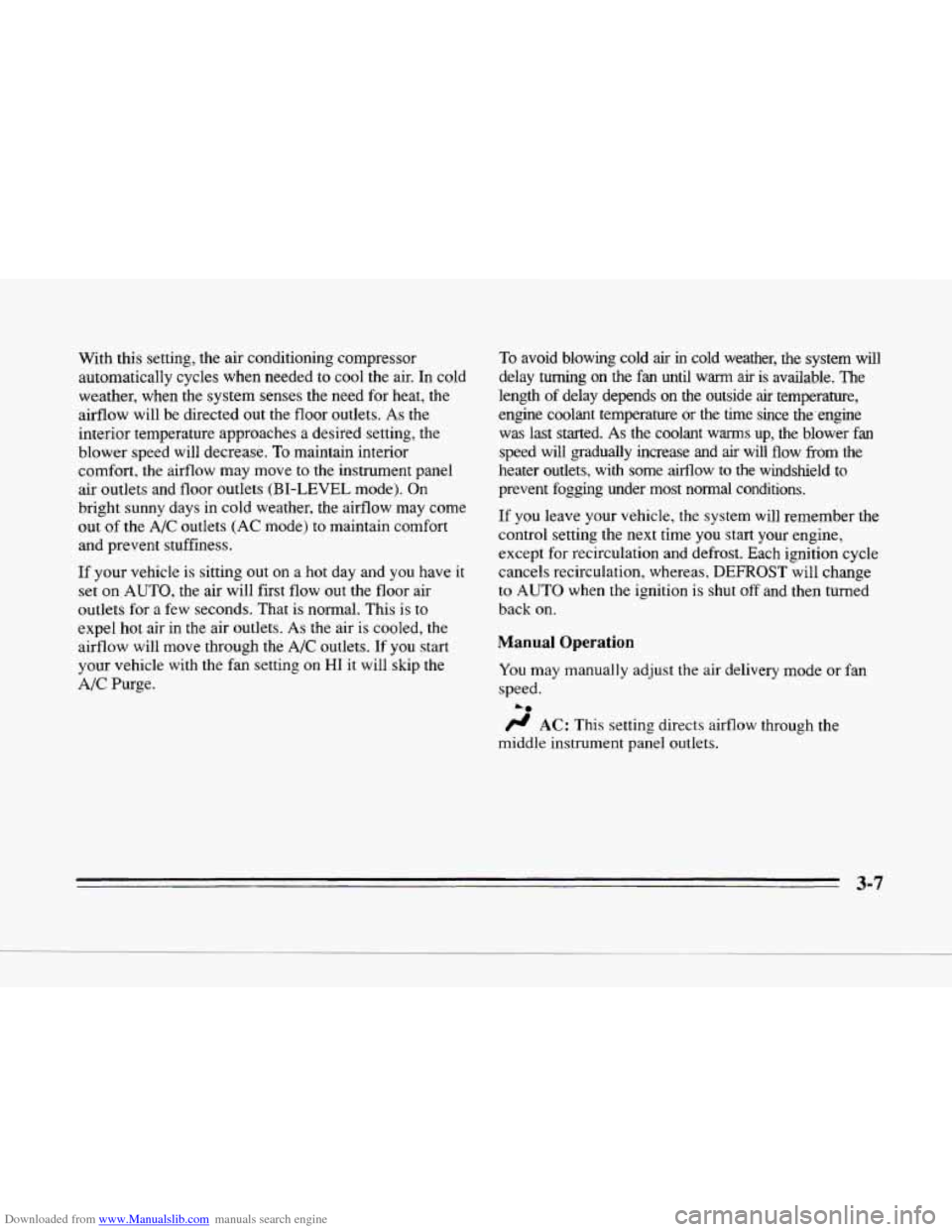
Downloaded from www.Manualslib.com manuals search engine c
c
With this setting, the air conditioning compressor
automatically cycles when needed to cool the air.
In cold
weather, when the system senses the need for heat, the
airflow will be directed out
the floor outlets. As the
interior temperature approaches a desired setting, the
blower speed
will decrease. To maintain interior
comfort, the airflow may move
to the instrument panel
air outlets and floor outlets
(BI-LEVEL mode). On
bright sunny days in cold weather, the airflow may come
out
of the A/C outlets (AC mode) to maintain comfort
and prevent stuffiness.
If your vehicle is sitting
out on a hot day and you have it
set on AUTO, the air will first flow out the floor air
outlets for a few seconds. That is normal. This
is to
expel hot air in the air outlets. As the air is cooled, the
airflow will move through the A/C outlets. If you start
your vehicle
with the fan setting on HI it will skip the
A/C Purge.
To avoid blowing cold air in cold weather, the system will
delay turning on the fan until warm
air is available. The
length of delay depends on the outside
air temperature,
engine coolant temperature or the time since the'engine
was last started.
As the coolant warms up, the blower fan
speed will gradually increase and
air will flow from the
heater outlets, with some airflow to the windshield to
prevent fogging under most normal conditions.
If you leave your vehicle, the system will remember the
control setting the next time you start your engine,
except for recirculation and defrost. Each ignition cycle
cancels recirculation, whereas,
DEFROST will change
to AUTO when the ignition is shut off and then turned
back
on.
Manual Operation
You may manually adjust the air delivery mode or fan
speed.
be
/I AC: This setting directs airflow through the
middle instrument panel outlets.
3-7